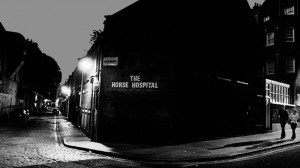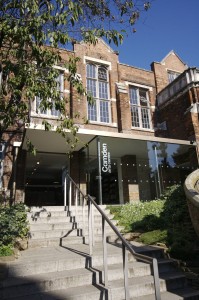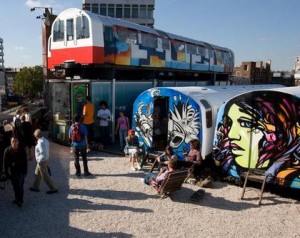There are plenty of London art galleries that give you exactly what you’d expect – art and plenty of it, be that modern, traditional, post-modern, the works. But if you venture beyond the Tates or the National Portrait Gallery you can find some of the galleries in London give you a little more than you might bargain for. And it’s all free!
Proud Camden
Proud opened to huge expectations and has far exceeded them, so ignore the rest of Camden Market and head straight for this gallery/music venue/bar. Located behind Camden Stables, Proud is build on its enthusiastic staff and their expert choice of art and music. Popular shows have included photos of reggae legends Burning Spear, Peter Tosh, Bob Marley and Lee ‘Scratch’ Perry during the Golden Age. It fills up at night, but if you go during the day you can have the art and the £6.50 beer-and-burger special to yourself.
Horse Hospital
Horse Hospital is proud to present everything you can’t see elsewhere in music, film, fashion and art. They also offer free beer at monthly horror film screenings. Previous screenings include the cult CUT! series horror flicks, featuring Norman Reedus of Blade II and The Walking Dead. In addition, Horse Hospital is home to the UK’s largest indie documentary festival, LIDF. Top tip: do not wear tricky footwear – the entry ramp was built for horses not heels.
Brancolini Grimaldi
Italy’s first contemporary photography gallery, Brancolini Grimaldo opened its London branch in April 2011.
Works on show combine photography, video and installation art, and the aim is to highlight upcoming talent. It looks like a regular office building from the outside, so the sheer space and amount of light inside are a surprise. It’s gorgeous and the art is not what you might expect. Early shows included works by Marie Amar, Pino Pascali and Clare Strand.
Camden Arts Centre
The range of free exhibitions, live performances and talks with resident or visiting artists puts Camden Arts Centre firmly in the hot category. In fact, it doesn’t feel like a gallery so much as a place where people make great art.
The Centre’s main focus is on top quality art education, and all the student projects and children’s activities are artist-taught or commissioned. You can learn about pretty much any aspect of art here, from scriptwriting to dance, from the experts. Marta Marcé and Turner Prize-winner Simon Starling are just two of the standout names that have worked or curated for Camden Arts.
John Martin Gallery
The John Martin Gallery provides two perfect floors of commercial gallery space in the heart of Mayfair’s art world. JM London showcases mainly British and Irish artists, including Andrew Gifford and Richard Cartwright. The periodic group shows are excellent samples of contemporary landscape painting. The gallery assistants are very informative and helpful, even to the casual visitor.
Village Underground
Part disused tube trains, part Victorian warehouse-cum-mechanic’s, Village Underground is a work in progress. The original idea was to create free studio space for artists amid rising Shoreditch rents. Far more than just a gallery, this renovated, formerly derelict warehouse plays host to concerts, club nights, exhibitions, theatre and live art – there’s no regular schedule so you should always check what’s on beforehand. Strictly not-for-profit, the decommissioned Jubilee line trains and shipping containers accommodate up to 50 artists, writers, designers and filmmakers (spaces are, unsurprisingly, like gold dust). There’s no actual sign, so just look for a wall of graffiti and a gate and press the buzzer. The main floor is the gallery and music venue, with studios and extra performance area above.
Whitechapel Gallery
Possibly the East End’s most famous gallery bar White Cube 2, and definitely its oldest at 100, the Whitechapel gallery is a striking example of east London contrasts: a beautiful modern venue surrounded by old-fashioned neighbourhood chaos. Formerly known as the University of the Ghetto, the Whitechapel contains nine small galleries, a library, and a proper dining room. The bookshop is incredibly well stocked – no gift shop tat, just heavy art books and magazines like Frieze and Art Monthly. You can also buy limited edition prints by some artists


